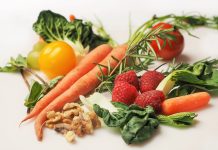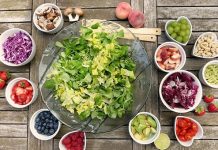Have You Heard About The Dash Diet Plan?
Note: This is a review. Click here to get the DASH Diet Plan!
What Does The DASH Diet Stand For?
Dietary approaches to stop hypertension, or the DASH Diet, is a dietary program made specifically to reduce blood pressure.
It has modest amounts of lean proteins and nuts and is largely composed of fruits, vegetables, whole grains, and low-fat dairy products.
The DASH Diet has only trace levels of added carbohydrates and sodium and is low in saturated fat, total fat, and cholesterol.
The American Heart Association and other health organizations advocate it as a healthy dietary pattern for the general populace since it has been demonstrated to be beneficial in decreasing blood pressure. 
How Does The DASH Diet Work?
The DASH diet works by offering a balanced combination of nutrients including potassium, magnesium, and calcium.
These nutrients work by aiding in blood vessel relaxation and heart stress reduction, which can lower blood pressure.
The DASH Diet’s primary goal isn’t what you might think. Weight loss is secondary to lowering blood pressure.
However, the ability to manage or avoid diabetes, reduce cholesterol, and decrease weight are excellent side benefits of this plan.
Although the DASH diet is not vegetarian, it does include more fruits, vegetables, low- or nonfat dairy products, beans, nuts, and other healthy foods than most people currently eat.
In addition to being low in salt and added sugars, the DASH diet is also low in cholesterol, total fat, and saturated fat.
This dietary components reduction may also be a factor in the DASH diet’s ability to decrease blood pressure.
And while the science is not clear on all the purported benefits, this is a nutritious and balanced eating plan that anyone wishing to enhance their general health can easily try out.
What Can I Eat On The DASH Diet?
Foods from all dietary groups are included in the DASH diet, including:
Fruits: Each day, try to consume 4-5 servings of a variety of fresh, frozen, or canned fruits. Bananas, apples, oranges, berries, and melon are a few tasty alternatives.
Vegetables: 4-5 servings of a variety of veggies should be consumed daily. Pick a variety of veggies, including leafy greens, broccoli, peppers, tomatoes, and squash, in various shapes and colors.
Grains: For at least 6–8 servings per day, choose whole grains including whole wheat, brown rice, oats, and quinoa.
Lean proteins: For 2-3 meals each day, choose lean sources of protein such chicken, turkey, fish, beans, and tofu.
Low-fat dairy: For 2-3 servings per day, choose low-fat or fat-free milk, yogurt, and cheese.
Include a small number of nuts, seeds, and legumes in your diet each day, such as almonds, peanuts, and lentils.
The DASH Diet also contains a restricted amount of sodium and added sugars.
You will need to check food labels carefully for salt and sugar to ensure compliance with these restrictions.
And of course, water is the drink of choice on this plan as it should always be.
Lastly, it advises totally avoiding processed foods ala “junk foods”.
DASH Diet Sample Meal Plan
Here is an example DASH diet food plan for the day:
Breakfast: Scrambled eggs with whole grain toast and sliced tomato
Lunch: Grilled salmon with brown rice and steamed broccoli
Snack: Carrot sticks with hummus
Dinner: Black bean and sweet potato tacos with mixed greens salad
Dessert: Banana with nonfat Greek yogurt and chopped nuts
DASH Diet Exercise Component
Does the DASH Diet recommend exercise?
Regular physical exercise is crucial for preserving an acceptable blood pressure and overall health, in addition to adhering to the DASH diet.
The American Heart Association suggests engaging in at least 150 minutes of aerobic activity of moderate level or 75 minutes of activity of vigorous intensity per week, or a mix of the two.
Muscle-strengthening exercises should be performed at least twice a week. 
Brisk walking, cycling, dancing, and gardening are a few examples of moderate-intensity aerobic exercise.
Exercises that need a lot of energy include sprinting, jumping rope, and swimming laps. Exercises that build muscle can be done with weights, resistance bands, or your own body weight, such as push-ups and squats.
DASH Diet Pros
The DASH Diet is high in fruits, vegetables, whole grains, and low-fat dairy products, all of which are linked to lower blood pressure.
The DASH Diet is also low in cholesterol and saturated fat, which possibly helps to lower cholesterol levels.
It is a low-calorie eating plan that might aid in weight loss.
The plan possibly lowers the risk of heart disease, stroke, and several cancers.
It also offers precise guidelines for daily intake of several food groups, which may make it simpler for people to adhere to.
DASH Diet Cons
Requires making considerable adjustments to your food and eating habits, which could be challenging for some people.
It can be expensive due to its reliance on whole foods
It could be difficult for some people to eat the necessary amount of fruits, vegetables, and other plant-based foods.
Might be difficult to get enough protein.
Due to its high potassium content, it might not be suited for those with specific medical conditions, such as kidney illness.
Conclusion
Overall, the DASH diet is regarded as a healthy, balanced diet that might be good for a variety of people.
It is abundant in fruits, vegetables, whole grains, and other plant-based foods, all of which are significant nutrient sources and may help lower the risk of developing a number of diseases.
Additionally, it contains little sodium and added sugar, which is good for maintaining a healthy blood pressure and overall wellbeing.
To determine whether the DASH diet is a good fit for you, take into account your unique needs and preferences as it may not be appropriate for everyone.
But no matter the results, eating this way CANNOT hurt you.
Citations:
- “How to Make the DASH Diet Work for You.” Mayo Clinic, 25 June 2021, www.mayoclinic.org/healthy-lifestyle/nutrition-and-healthy-eating/in-depth/dash-diet/art-20048456.
- “DASH Eating Plan.” NHLBI, NIH, 4 Jan. 2021, www.nhlbi.nih.gov/education/dash-eating-plan.
- “Diet Review: DASH.” The Nutrition Source, 16 Jan. 2018, www.hsph.harvard.edu/nutritionsource/healthy-weight/diet-reviews/dash-diet.
- The DASH Diet Plan - January 5, 2023
-
How To Do Portion Control For Weight Loss - June 30, 2022 - The Belly Fat Cure - November 13, 2021






















